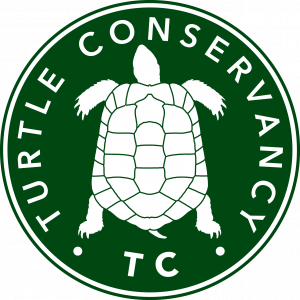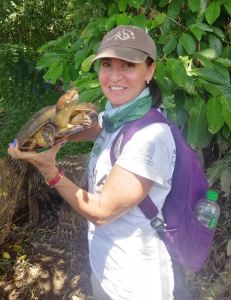Vivian P. Páez
Vivian Páez Receives the 17th Annual 2022 Behler Turtle Conservation Award
Vivian Páez, 2022 Behler Turtle Conservation Award Honoree
by Brian Bock, Anders G.J. Rhodin, and Rick Hudson
From: Turtle Survival magazine 2022:60–61
(download pdf here)
This year’s 17th Annual Behler Turtle Conservation Award honors Dr. Vivian P. Páez of Colombia. The award, considered the “Nobel Prize” of turtle conservation and biology, honors and celebrates extraordinary dedication and influential leadership in the international chelonian community.
Vivian was born and raised in Bogotá, Colombia. Growing up, Vivian developed a passion for biology, which led her to study Biology in college, first at the Universidad Nacional de Colombia and then at the Universidad de los Andes, where she obtained her degree in 1987. Needing more experience conducting field work, she took a fellowship as field assistant at the Smithsonian Tropical Research Institute in Panama, working on nesting ecology of green iguanas, and where she also met her eventual husband, Brian Bock. While collecting hatchling iguanas at a study site one day, she also found some hatchling turtles, as a female Trachemys venusta uhrigi had also nested at the site. These hatchling turtles had a profound effect on her, and when her fellowship ended, she decided to continue her education by pursuing graduate school to study turtle ecology in Colombia. However, her fellowship mentor, Stan Rand, while encouraging her academic interests, cautioned that turtles were not considered “model organisms” in the area of reptile ecology.
Undaunted, Vivian entered the doctoral program at Ohio University in Athens, Ohio, USA, to study turtle ecology. Although her English was initially weak, her advisor, Scott Moody, made special arrangements for her to take graduate classes and receive a teaching assistant grant while also taking an intensive English language program. Her English rapidly improved, and by the end of her graduate career, she was awarded the Graduate Student of the Year award of the College of Arts and Sciences at Ohio University.
However, while Scott Moody played a key role in Vivian’s academic formation, he felt that he should not independently direct a doctoral thesis on turtle ecology, not being a turtle biologist himself, so he advised Vivian to send her doctoral research proposal (on the nesting ecology of Podocnemis unifilis) to Richard Vogt for his input. Vogt responded with a scathing critique of her proposal, saying it showed she had no experience working with freshwater turtles, but his review also ended with an invitation for her to participate (free of charge) in an upcoming graduate course he was offering on field methods for the study of turtles in Mexico. Vivian accepted his offer and spent two weeks in Mexico learning how to trap, mark, stomach pump, and otherwise study all aspects of freshwater turtle ecology in the field. This trip marked the beginning of a life-long relationship of mutual respect, collaboration, and friendship between Richard and Vivian that had as its common ground their mutual interests in freshwater turtle ecology.
Vivian then returned to Colombia where she obtained government support for field work with her now-husband Brian on the Caquetá River and Cauhinarí Natural National Park. With Colombian support in hand, they obtained matching funding thanks to John Thorbjarnarson of the Wildlife Conservation Society in New York. During the project, Vivian and Brian also were invited to attend the seminal International Turtle Congress in Purchase, New York, where they first met and befriended Olga Castaño-Mora, the grande dame of Colombia turtle biology, as well as many other important figures in the international turtle research and conservation arena, including Anders Rhodin, Peter Pritchard, and John Behler.
After finishing her doctoral thesis, Vivian was offered a teaching position in the Instituto de Biología of the Universidad de Antioquia in Medellín, Colombia. Far from the Colombian Amazon, it became more feasible for her to focus on turtles in the nearby Magdalena River. She also founded the Grupo Herpetológico de Antioquia and the Museo de Herpetología of the Universidad de Antioquia. During her long academic career at the Universidad de Antioquia, she addressed turtle topics as varied as temperature-dependent sex determination, maternal effects and other aspects of nesting ecology, habitat use, growth rates, movement patterns, demographic monitoring and matrix projections, population genetics, niche modelling and climate change, management methods, heavy metal accumulation, and ethnozoology. She also mentored many undergraduate and graduate thesis students, and saw many of them obtain positions in other Colombian universities, NGOs, and government environmental institutions.
Vivian has also had an impact on national and international aspects of turtle biology and conservation. At the national level, she organized four symposia on turtle biology at national professional meetings, and was elected vice-president of the Asociación Colombiana de Herpetologia in 2006 and president in 2010. As president of ACH she organized a workshop in 2011 to produce a revised conservation action plan for Colombian turtles. One of the goals was to synthesize current knowledge of the continental turtle species in Colombia, and she spearheaded a collaborative editing effort that resulted in the 2012 book Biología y Conservación de las Tortugas Continentales de Colombia. A follow-up workshop was held in 2015, this time along with the Colombian Environmental Ministry, where an update to the last action plan was produced and approved officially by the Colombian government. Vivian also was an editor of the 2015 Libro Rojo de Reptiles de Colombia to classify reptiles in Colombia at the national level using IUCN criteria. Her most recent publication is an updated checklist of the turtles of Colombia with annotated analysis of their distributions in Colombia and conservation status.
At the International level, Vivian has been a longterm member of the Steering Committee of the IUCN Tortoise and Freshwater Turtle Specialist Group, a member of the Review Board of the Turtle Conservation Fund, and more recently also of the Congdon-Dickson Turtle Ecology Fund. She has been an editor for Chelonian Conservation and Biology for many years, and more recently has taken on the role of assistant editor for turtles for Herpetological Conservation and Biology and Revista Latinoamericana de Herpetologia. She has recently accepted the task of becoming the new IUCN Red List Coordinator of the TFTSG.
In 2013, she was honored to receive the first Sabin Turtle Conservation Prize for her career dedicated to turtle research and conservation. The Behler Turtle Conservation Award now represents another major honor that highlights her career-long dedication to turtle research and conservation of Colombian turtles. She is an exceptional leader in our global community and represents the growing importance of turtle conservation efforts focused on South America.
Throughout her career, Brian has been at Vivian’s side, collaborating with her on turtle research and conservation, as well as raising their daughter Jessica, who is now a college student entering her senior year studying biological conservation and environmental education. Jessica and Brian could not be prouder of Vivian for this Behler Award recognition, as are both Rick and Anders as they’ve followed her career and watched her accomplishments grow over the years. Congratulations to her from the entire turtle conservation community.










